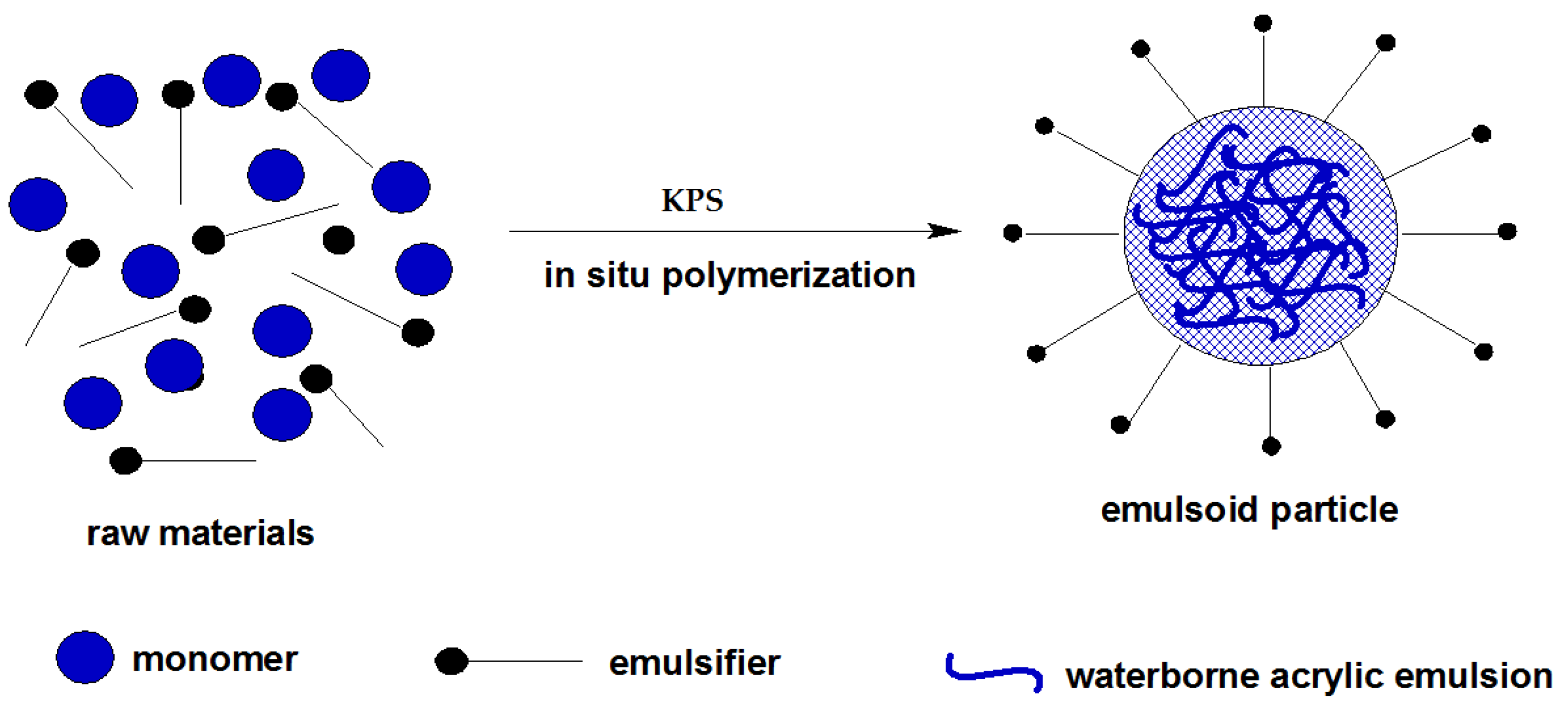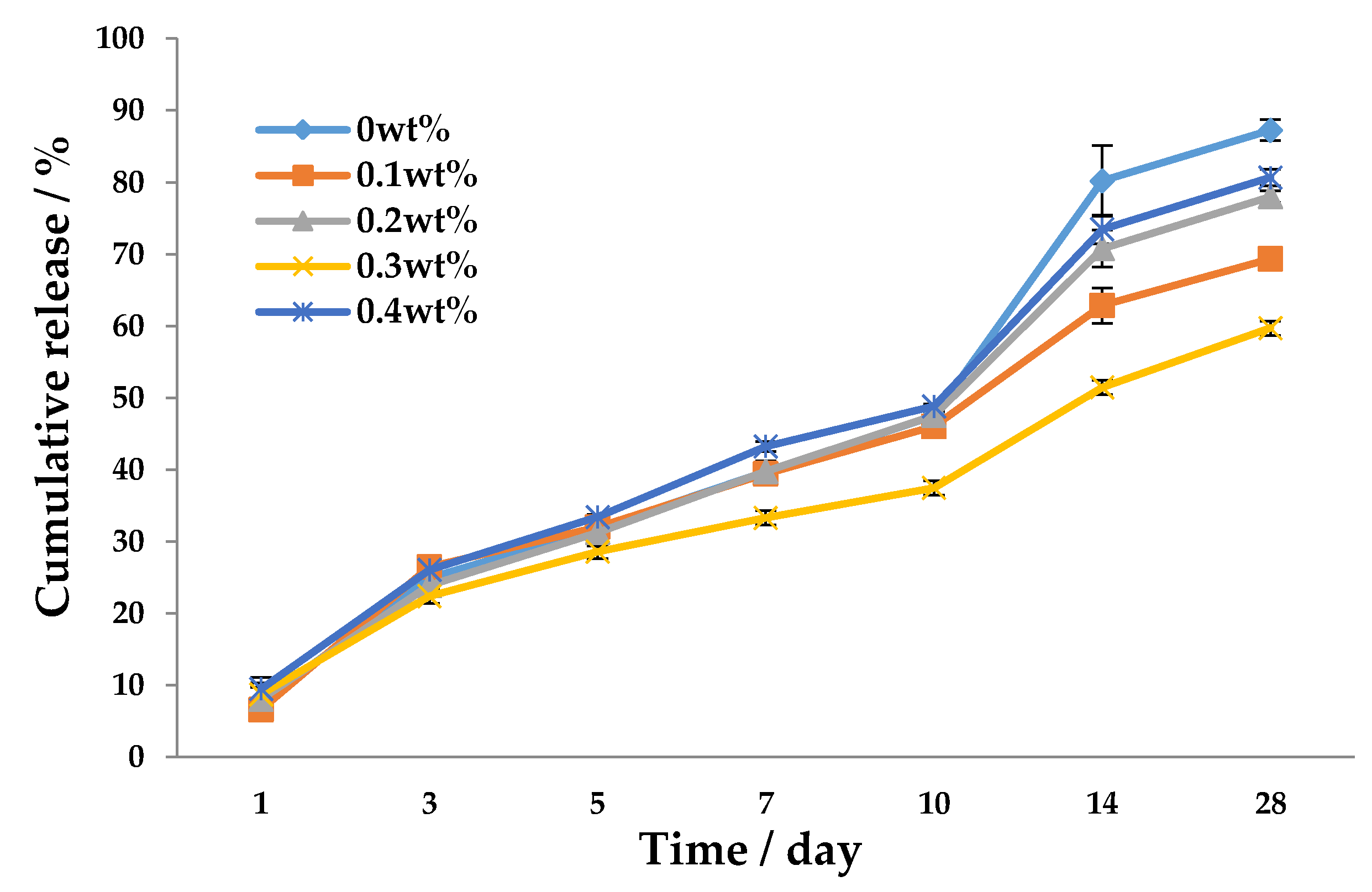Application of Graphene-Oxide-Modified Polyacrylate Polymer for Controlled-Release Coated Urea
Abstract
:1. Introduction
2. Materials and Methods
2.1. Materials
2.2. Synthesis of Polyacrylate Polymer
2.3. Fabrication of PA/GO Composites and Preparation of Film Samples
2.4. Characterization of the Film Samples
2.5. Preparation of Controlled-Release Coated Urea
2.6. Nitrogen Release Characteristic of Controlled-Release Coated Urea
3. Results and Discussion
3.1. Synthesis of PA/GO Composites
3.2. Characterizations of the Film Samples
3.2.1. The Swelling Degree of the Film Samples
3.2.2. The Glass Transition Temperature of Film Samples
3.2.3. Mechanical Properties
3.2.4. FTIR-PAS Analysis
3.3. Nutrient Release Behavior of CRU
4. Conclusions
Acknowledgments
Author Contributions
Conflicts of Interest
References
- Fan, S.; Pardey, P.G. Research, productivity, and output growth in Chinese agriculture. J. Dev. Econ. 1997, 53, 115–137. [Google Scholar] [CrossRef]
- Zhu, Z.; Chen, D. Nitrogen fertilizer use in China—Contributions to food production, impacts on the environment and best management strategies. Nutr. Cycl. Agroecosyst. 2002, 63, 117–127. [Google Scholar] [CrossRef]
- Heffer, P.; Prud’homme, M. Fertilizer Outlook 2017–2021. In Proceedings of the 85th IFA Annual Conference, Marrakech, Morocco, 22–24 May 2017. [Google Scholar]
- Mosier, A.R.; Syers, J.K.; Freney, J.R. Nitrogen fertilizer: An essential component of food, feed, and fiber production. In Agriculture and the Nitrogen Cycle: Assessing the Impacts of Fertilizer Use on Food Production and the Environment; Island Press: St. Louis, MO, USA, 2004. [Google Scholar]
- Van Cleemput, O.; Zapata, F.; Vanlauwe, B. Use of Tracer Technology in Mineral Fertilizer Management. In Guidelines on Nitrogen Management in Agricultural Systems; IAEA: Vienna, Austria, 2008; pp. 19–125. [Google Scholar]
- Dobermann, A. Nitrogen use efficiency—State of the art. In Proceedings of the IFA International Workshop on Enhanced-Efficiency Fertilizers, Frankfurt, Germany, 28–30 June 2005. [Google Scholar]
- Smil, V.A. Nitrogen in crop production: An account of global flows. Glob. Biogeochem. Cycles 1999, 3, 647–662. [Google Scholar] [CrossRef]
- Mikkelsen, R.L. Using hydrophilic polymers to improve uptake of manganese fertilizers by soybeans. Nutr. Cycl. Agroecosyst. 1995, 41, 87–92. [Google Scholar] [CrossRef]
- Yan, X. Recent Advances on the technologies to increase fertilizer use efficiency. J. Intergr. Agric. 2008, 7, 469–479. [Google Scholar] [CrossRef]
- Majeed, Z.; Ramli, N.K.; Mansor, N.; Man, Z. A comprehensive review on biodegradable polymers and their blends used in controlled-release fertilizer processes. Rev. Chem. Eng. 2015, 31, 69–96. [Google Scholar] [CrossRef]
- Shaviv, A. Advances in controlled-release fertilizers. Adv. Agron. 2001, 71, 1–49. [Google Scholar]
- Treinyte, J.; Grazuleviciene, V.; Paleckiene, R.; Ostrauskaite, J.; Cesoniene, L. Biodegradable Polymer Composites as Coating Materials for Granular Fertilizers. J. Polym. Environ. 2017, in press. [Google Scholar] [CrossRef]
- Zhang, F.-D.; Wang, Y.-J. Current situation and development trend of slow/controlled release fertilizer in China. Soil Fertil. Sci. Chin. 2008, 26, 1–4. (In Chinese) [Google Scholar]
- Da Rosa, S.G.; dos Santos Rocha, S.C. Effect of process conditions on particle growth for spouted bed coating of urea. Chem. Eng. Process. Process Intensif. 2010, 49, 836–842. [Google Scholar] [CrossRef]
- Donida, M.W.; Rocha, S.C.S. Coating of urea with an aqueous polymeric suspension ion a two-dimensional spouted bed. Dry. Technol. 2002, 20, 685–704. [Google Scholar] [CrossRef]
- Zhou, Z.; Du, C.; Li, T.; Shen, Y.; Zeng, Y.; Du, J.; Zhou, J. Biodegradation of a biochar-modified waterborne polyacrylate membrane coating for controlled-release fertilizer and its effects on soil bacterial community profiles. Environ. Sci. Pollut. Res. 2015, 22, 8672–8682. [Google Scholar] [CrossRef] [PubMed]
- Shen, Y.; Zhao, Z.; Zhou, J.; Du, C. Application of waterborne acrylicemulsions in coated controlled release fertilizer using reacted layer technology. Chin. J. Chem. Eng. 2015, 23, 309–314. [Google Scholar] [CrossRef]
- Geim, A.K.; Novoselov, K.S. The rise of graphene. Nat. Mater. 2007, 6, 183–191. [Google Scholar] [CrossRef] [PubMed]
- Sengupta, R.; Bhattacharya, M.; Bandyopadhyay, S.; Bhowmick, A.K. A review on the mechanical and electrical properties of graphite and modified graphite reinforced polymer composites. Prog. Polym. Sci. 2011, 36, 638–670. [Google Scholar] [CrossRef]
- Bolotin, K.I.; Sikes, K.J.; Jiang, Z.; Klima, M.; Fudenberg, G.; Hone, J.; Kim, P.; Stormer, H.L. Ultrahigh electron mobility in suspended graphene. Solid State Commun. 2008, 146, 351–355. [Google Scholar] [CrossRef]
- Suk, J.W.; Piner, R.D.; An, J.; Ruoff, R.S. Mechanical properties of monolayer graphene oxide. ACS Nano 2010, 4, 6557–6564. [Google Scholar] [CrossRef] [PubMed]
- Lee, C.; Wei, X.D.; Kysar, J.W.; Hone, J. Measurement of the elastic properties and intrinsic strength of monolayer graphene. Science 2008, 321, 385–388. [Google Scholar] [CrossRef] [PubMed]
- Konios, D.; Stylianakis, M.M.; Stratakis, E.; Kymakis, E. Dispersion behaviour of graphene oxide and reduced graphene oxide. J. Colloid Interface Sci. 2014, 430, 108–112. [Google Scholar] [CrossRef] [PubMed]
- Dreyer, D.R.; Park, S.; Bielawski, C.W.; Ruoff, R.S. The chemistry of graphene oxide. Chem. Soc. Rev. 2010, 39, 228–240. [Google Scholar] [CrossRef] [PubMed]
- Klunbud, P.; Suktha, P.; Sawangphruk, M. Decoration of graphene oxide nanosheets with amino silane-functionalized silica nanoparticles for enhancing thermal and mechanical properties of polypropylene nanocomposites. J. Appl. Polym. Sci. 2016, 133, 44382. [Google Scholar] [CrossRef]
- Fang, M.; Wang, K.; Lu, H.; Yang, Y.; Nutt, S. Covalent polymer functionalization of graphene nanosheets and mechanical properties of composites. J. Mater. Chem. 2009, 19, 7098–7105. [Google Scholar] [CrossRef]
- Li, P.Y.; Cheng, K.Y.; Zheng, X.C.; Liu, P.; Xu, X.J. Facile synthesis of water-soluble graphene-based composite: Non-covalently functionalized with chitosan-ionic liquid conjugation. Funct. Mater. Lett. 2016, 9, 1650045. [Google Scholar] [CrossRef]
- Texter, J. Graphene oxide and graphene flakes as stabilizers and dispersingaids. Curr. Opin. Colloid Interface Sci. 2015, 20, 454–464. [Google Scholar] [CrossRef]
- Wang, M.; Duan, X.; Xu, Y.; Duan, X. Functional three-dimensional graphene/polymer composites. ACS Nano 2016, 10, 7231–7247. [Google Scholar] [CrossRef] [PubMed]
- Huh, C.D.S.; Jung, K. Polypyrrole/graphene oxide composites with improved conductivity and solubility. Conduct. Polym. 2012, 50, 10–11. [Google Scholar]
- Wang, Y.; Shi, Z.; Fang, J.; Xu, H.; Yin, J. Graphene oxide/polybenzimidazole composites fabricated by a solvent-exchange method. Carbon 2011, 49, 1199–1207. [Google Scholar] [CrossRef]
- Chen, H.F.; Miao, Y.; Ke, S.S. Preparation and Performance of Polypropylene/Modified Carbon Fibers by Physical Blending Method. Mater. Sci. Forum 2014, 809, 105–108. [Google Scholar] [CrossRef]
- Xie, F.; Liu, Z.; Wei, D. Curing kinetics and properties of acrylic resin cured with aziridine crosslinker. Chin. J. Polym. Sci. 2002, 20, 65–70. [Google Scholar]
- GB/T 23348-2009 Slow Release Fertilizer; China Standard Press: Beijing, China, 2009.
- Shen, Y.; Du, C.W.; Zhou, J.M.; Ma, F. Application of nano FeIII-tannic acid complexes in modifying aqueous acrylic latex for controlled-release coated urea. J. Agric. Food Chem. 2017, 65, 1030–1036. [Google Scholar] [CrossRef] [PubMed]
- Spasevska, D.; Leal, G.P.; Fernández, M.; Blazevska Gilev, J.; Paulisb, M.; Tomovska, R. Crosslinked reduced graphene oxide/polymer composites via in situsynthesis by semicontinuous emulsion polymerization. RSC Adv. 2015, 5, 16414–16421. [Google Scholar] [CrossRef]
- Satti, A.; Larpent, P.; Gun’Ko, Y. Improvement of mechanical properties of graphene oxide/poly(allylamine) composites by chemical crosslinking. Carbon 2010, 48, 3376–3381. [Google Scholar] [CrossRef]
- Zhao, C.; Shen, Y.; Du, C.; Zhou, J.; Wang, H.; Chen, X. Evaluation of waterborne coating for controlled-release fertilizer using wurster fluidized bed. Ind. Eng. Chem. Res. 2010, 49, 9644–9647. [Google Scholar]
- Gaur, U.; Wunderlich, B. The glass transition temperature of polyethylene. Macromolecules 1980, 13, 445–446. [Google Scholar] [CrossRef]
- Lee, S.; Kim, Y.; Kim, D.; Ku, B.; Joh, H. Synthesis and properties of thermally reduced graphene oxide/polyacrylonitrile composites. J. Phys. Chem. Solids 2012, 73, 741–743. [Google Scholar] [CrossRef]
- Du, C.; Zhou, G.; Wang, H.; Chen, X.; Zhou, J. Depth profiling of clay-xanthan complexes using step-scan mid-infrared photoacoustic spectroscopy. J. Soils Sedim. 2010, 10, 855–862. [Google Scholar] [CrossRef]






| GO Content (wt %) | Tg (°C) | Stress at Break (MPa) | Strain at Break (%) | Young’s Modulus (MPa) |
|---|---|---|---|---|
| 0 | 4.21 | 4.88 ± 0.57 | 814.5 ± 24.6 | 31.52 ± 4.65 |
| 0.1 | 5.77 | 3.66 ± 0.41 | 742.8 ± 37.3 | 33.94 ± 1.85 |
| 0.2 | 5.80 | 3.68 ± 0.29 | 753.9 ± 29.8 | 34.76 ± 3.44 |
| 0.3 | 5.43 | 4.03 ± 0.40 | 724.2 ± 46.8 | 27.42 ± 3.83 |
| 0.4 | 6.11 | 5.57 ± 0.39 | 911.5 ± 14.1 | 34.97 ± 1.02 |
| Wavenumber (cm−1) | Assignment |
|---|---|
| 2950 | C–H stretching (–CH3) |
| 2349 | C=O symmetrical stretching (CO2) |
| 1730 | C=O stretching (COOR) |
| 1450 | C–H deformation (–CH3, –CH2−) |
| 1160 | C–O–C stretching (–COOR) |
| 900–990 | C–C stretch(lipid skeleton) |
© 2018 by the authors. Licensee MDPI, Basel, Switzerland. This article is an open access article distributed under the terms and conditions of the Creative Commons Attribution (CC BY) license (http://creativecommons.org/licenses/by/4.0/).
Share and Cite
Yuan, W.; Shen, Y.; Ma, F.; Du, C. Application of Graphene-Oxide-Modified Polyacrylate Polymer for Controlled-Release Coated Urea. Coatings 2018, 8, 64. https://doi.org/10.3390/coatings8020064
Yuan W, Shen Y, Ma F, Du C. Application of Graphene-Oxide-Modified Polyacrylate Polymer for Controlled-Release Coated Urea. Coatings. 2018; 8(2):64. https://doi.org/10.3390/coatings8020064
Chicago/Turabian StyleYuan, Wenjun, Yazhen Shen, Fei Ma, and Changwen Du. 2018. "Application of Graphene-Oxide-Modified Polyacrylate Polymer for Controlled-Release Coated Urea" Coatings 8, no. 2: 64. https://doi.org/10.3390/coatings8020064





